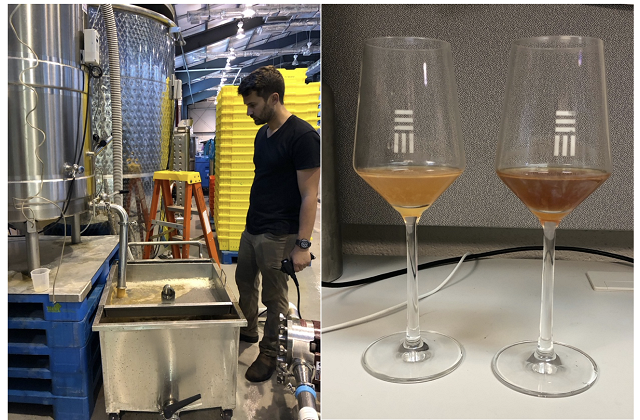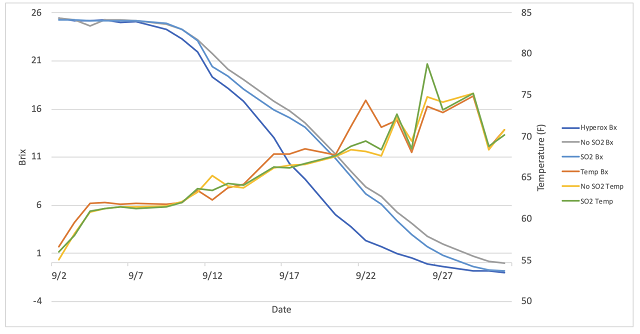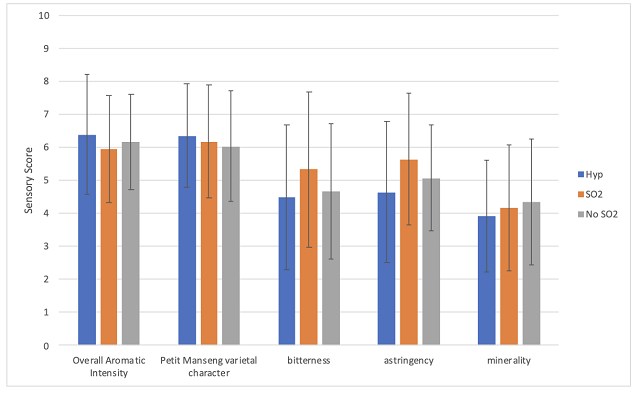Oxidative Winemaking in Petit Manseng: Low SO2 and Hyperoxygenation
Ben Jordan and Maya Hood White
Early Mountain Vineyard
Summary
Since its introduction to Virginia in 1987, Petit Manseng has become increasingly popular due to its ability to ripen and resist rot in Virginia’s hot humid climate. However, this variety frequently has high sugar, high acid, and intense tropical fruit characteristics at harvest. Hyperoxygenation is one approach to reducing tropical fruit characteristics that can sometimes be out of balance as well as removing phenolics picked up during skin contact. The purpose of this study was to explore the chemical and sensory impacts of permissive oxygen management and hyperoxygenation in Petit Manseng winemaking. There was little difference in the chemistry of finished wines based on oxygen management. There were also no significant differences in overall aromatic intensity, Petit Manseng varietal character, bitterness, astringency or minerality.
Introduction
Petit Manseng was introduced to Virginia by Dr. Tony Wolf in 1987 as part of vineyard variety trials and has since become popular among grape growers in Virginia for its loose clusters, thick skins, and resistance to bunch rots1,2. In the last 30 years, popularity has grown such that Virginia now boasts the second largest planting of Petit Manseng in the world after France with more than 64 acres of Petit Manseng planted around the state2,3. Petit Manseng wines are described as having unique fruity and spicy aromas such as pineapple, peach, melon, grapefruit, nutmeg, honey, wildflowers, box tree, and roasted coffee bean4. Notable levels of thiols5 and esters6 have been measured in wines made from Petit Manseng grapes and contribute to these descriptors.
This variety is often harvested with high levels of acidity and low pH. This level of acidity is thought to contribute to good aging character, however, it also presents a challenge when coupled with the levels of alcohol found in dry Petit Manseng. One approach to moderating the acidity of Petit Manseng is to crush and destem the grapes and allow limited skin contact prior to pressing. However, skin contact can lead to the extraction of phenolics that lead to browning and astringency with age. Hyperoxygenation of juice can remove flavenols that lead to browning, bitterness and astringency and improve ageability of the wine7. However, hyperoxygenation may also have an effect on thiols and esters, changing the aromatic and fruit profiles of the wine7. Passive oxygen uptake during processing may be sufficient to allow the precipitation of flavenols without risk of lost aromatics7. In some cases, the intense tropical aromas of Petit Manseng are undesirable, so hyperoxygenation may be a useful tool to temper some of the thiols that lead to these aromas7.
The purpose of this study was to explore the management of oxygen in Petit Manseng winemaking. Specifically, does lack of SO2 at crush and subsequent oxidation, intentionally through hyperoxygenation or unintentionally through normal winery processes, help eliminate phenolics that cause browning and bitterness as Petit Manseng ages?
Methods
Pressing
Grapes were pressed with a modified whole cluster press (whole clusters with foot stomping in a tank press) into a single tank. After pressing, the tank was racked again into two tanks.
- The first receiving tank was set to 45°F (7°C) for cold settling. After cold settling, the juice from this tank was split into two tanks, one received an addition of 38 ppm SO2 (T1) while the other did not (T2).
- The second receiving tank was treated with hyperoxygenation of the juice. Juice was pumped through a sump until juice was brown (Figure 1). Dissolved oxygen and browning (absorbance at 420 nm) was measured before and after hyperoxygenation. After hyperoxygenation, the juice was cold settled in the same manner as the other treatments (T3).
All tanks were cold settled at 45°F for 24 hours, then racked into neutral barrels of similar cooperage, age, and dimension for fermentation. Juice was inoculated with a well-mixed ambient fermentation starter. Fermentations were monitored daily for Brix and temperature. Fermentation was carried out in a 65-70°F room with fermentation temperature reaching 75-80°F. At 16°Bx, the fermentations were inoculated with 0.15 g/L DV10 yeast rehydrated in 0.2 g/L GoFerm. Nutrient (Superfood and DAP) were added based on Brix level, at 1/3 and 1/2 Brix depletion. Barrels were warmed at 6°Brix and topped when fermentation reached 0°Brix.
The goal for this wine was to ferment to dryness. Though initially fermentation was on pace, tall three fermentations struggled when they reached Brix levels less than 0. In Petit Manseng, it is common for fermentations to be 1.5 – 2.0 Brix negative before residual sugar is fully utilized. For this reason, fermentations were re-started. Oenocell (0.3 g/L) was added an allowed to settle for 2-3 days. After racking off Oenocell, a pied de cuvée was prepared of water, wine, sugar to 5°Brix, and Fermaid O. Uvaferm 43 Restart yeast (0.4 g/L) was rehydrated in GoFerm (0.5 g/L) according to manufacturer’s instructions for restart rehydration. The pied de cuvée was added after 20 minutes and allowed to acclimate prior to addition to the larger lot of wine. When residual sugar was confirmed to be fully utilized, 30 ppm SO2 was added.
Sensory analysis was completed by a panel of 28 wine producers. Wines were presented blind in randomly numbered glasses. Tasters were presented with three wines and asked to score each wine on a scale of 0 to 10 for overall aromatic intensity, Petit Manseng varietal character, bitterness, astringency and minerality. There were three tasting groups, each tasting the wine in different order. Tasters were also given open ended questions to describe the wines. Descriptive scores were analyzed using repeated measures ANOVA.
Results
All treatments started with a single press load with typical juice chemistry for Petit Manseng (Table 1). Hyperoxygenation led to increases in dissolved oxygen as well as absorbance at 420nm (Table 2). Fermentation of hyperoxygenated juice was slightly faster than the other two treatments (Figure 2), however each treatment stalled in its fermentation prior to reaching a residual sugar <1.0 g/L. Table 3 summarizes the pace of fermentation for each treatment after 0°Brix. Primary wine chemistry is very much the same among treatments (Table 4). Residual sugar and A420nm for finished wine was <0.1 for all three treatments. Alcohol was 15.1% for all three (ICV labs Jan 2020). There were no significant differences in scores for overall aromatic intensity, Petit Manseng varietal character, bitterness, astringency, or minerality (Figure 3).
Table 1: Juice chemistry after racking (In-house data)

Figure 1: Juice was pumped from the tank through a sump cart to hyperoxygenate. This led to considerable browning.

Table 2: Change in dissolved oxygen and A420 with hyperoxygenation (In-house data)

Table 3: End of fermentation for three treatments of Petit Manseng (in-house data)

Figure 2: Fermentation kinetics for three treatments of Petit Manseng (in-house data)

Table 4: Primary wine chemistry for three treatments of Petit Manseng (ICV labs, Jan 2020)

Figure 3: Descriptive scores for three treatments of Petit Manseng (WRE)

References
(1) Wolf, T. K. Wine Grape Production Guide for Eastern North America; Plant and Life Sciences Publishing: Ithaca, New York, 2008.
(2) Robinson, J.; Harding, J.; Vouillamoz, J. Wine Grapes: A Complete Guide to 1368 Vine Varieties, Including Their Origins and Flavours, Illustrated Edition.; The Penguin Group: New York, 2012.
(3) SMS Research Advisors. 2019 Virginia Commercial Grape Report. 2020.
(4) Gardner, D. M.; Duncan, S. E.; Zoecklein, B. W. Aroma Characterization of Petit Manseng Wines Using Sensory Consensus Training, SPME GC-MS, and Electronic Nose Analysis. American Journal of Enology and Viticulture 2017, 68 (1), 112–119. https://doi.org/10.5344/ajev.2016.15099.
(5) Tominaga, T.; Baltenweck-Guyot, R.; Gachons, C. P. D.; Dubourdieu, D. Contribution of Volatile Thiols to the Aromas of White Wines Made From Several Vitis Vinifera Grape Varieties. Am J Enol Vitic. 2000, 51 (2), 178–181.
(6) Antalick, G.; Perello, M.-C.; Revel, G. de. Esters in Wines: New Insight through the Establishment of a Database of French Wines. Am J Enol Vitic. 2014, 65 (3), 293–304. https://doi.org/10.5344/ajev.2014.13133.
(7) Schneider, V. Must Hyperoxidation: A Review. American Journal of Enology and Viticulture 1998, 49(1).
